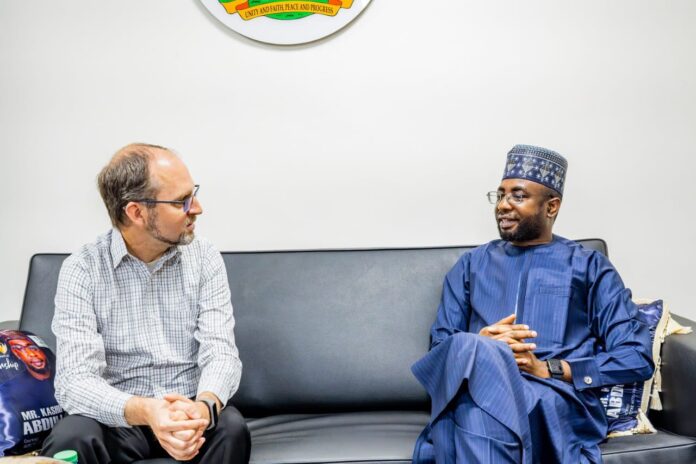Improving Food Security Using Digital Solutions
By Shuaib S. Agaka
Food is one of the basic necessities of life that every living being needs, in order to remain alive and become relevant in contributing towards societal productivity.
However, a lot of problems and challenges have been hindering the full realisation of the potential attributed to the agricultural sector in Nigeria and other developing countries, thereby making the project of food security unattainable.
In a positive light, a quiet revolution is underway, powered not by traditional tools alone, but by the digital innovations of the 21st century. At the heart of this transformation lies a strategic partnership between Nigeria’s National Information Technology Development Agency (NITDA) and the United States Agency for International Development (USAID), aimed at catalyzing progress in digital agriculture and ensuring food security across the nation.
This partnership represents a pivotal shift in agricultural practices, leveraging cutting-edge technologies to address age-old challenges and usher in a new era of sustainability and productivity.
Nigeria with its vast agricultural potential and growing population, faces a pressing need to modernize its farming practices to meet the demands of the food market. The integration of digital technologies such as the Internet of Things (IoT), Artificial Intelligence (AI), and blockchain into agriculture holds the promise of unlocking unprecedented efficiencies and insights.
Through the collaborative efforts of NITDA and USAID, these technologies can be harnessed to empower farmers, improve crop yields, optimize resource utilization, and enhance overall agricultural resilience.
By leveraging the expertise and resources of NITDA and USAID, Nigeria is poised to tap into the transformative potential of digital solutions tailored specifically for the agricultural domain. These solutions are designed to empower farmers, increase efficiency along the value chain, promote inclusive growth, and foster resilience in the face of evolving environmental and economic challenges.
One of the key pillars of this digital revolution in agriculture is the deployment of IoT solutions across farming landscapes. IoT-enabled sensors embedded in soil and crops will offer real-time data on moisture levels, nutrient content, and disease prevalence. This data, transmitted and analyzed through interconnected systems, enables farmers to make informed decisions regarding irrigation schedules, fertilizer application, and disease management.
The advent of IoT-enabled precision agriculture extends beyond basic monitoring to encompass predictive analytics and automated control systems. By analyzing data on environmental factors, crop health indicators, pest infestations, and equipment performance, farmers can proactively address challenges and optimize interventions. For example, predictive models can forecast disease outbreaks based on weather patterns, enabling measures such as targeted pest control or disease-resistant crop varieties.
Additionally, one of its significant advantages in agriculture is its ability to enhance resource efficiency and sustainability. By precisely monitoring soil conditions, water usage, and nutrient levels, farmers can optimize inputs such as fertilizers and irrigation, reducing waste and environmental impact. This not only conserves resources but also contributes to cost savings and long-term soil health, crucial factors for sustainable farming practices.
Moreover, the scalability of IoT solutions further enhances their impact across different scales of agricultural operations. From smallholder farms to large agribusiness enterprises, IoT technologies can be tailored to meet specific needs and challenges.
Complementing IoT advancements is the transformative potential of AI in agriculture, a domain where data-driven insights can unlock significant value. AI algorithms analyze vast datasets collected from farms, weather stations, and satellite imagery to generate actionable recommendations for farmers. From predicting optimal planting times and identifying crop diseases early to optimizing supply chain logistics and predicting market trends, AI empowers farmers with precision tools for decision-making, mitigating risks, and maximizing returns on investments.
At the core of AI-driven agriculture lies the ability to process vast amounts of data collected from diverse sources such as satellites, drones, IoT sensors, and farm machinery. These data streams encompass a range of variables including weather patterns, soil characteristics, crop health indicators, and pest infestations. By ingesting, processing, and analyzing this data in real time, AI systems can generate valuable recommendations and alerts for farmers, enabling them to make informed decisions promptly.
Read Also:
Also, AI in agriculture can be predictive modeling, where algorithms forecast outcomes based on historical data and current environmental conditions. For example, AI models can predict optimal planting times, recommend crop varieties suited to specific soil types, and forecast yield expectations based on weather forecasts and agronomic factors. By integrating these predictions into farm management practices, farmers can optimize input use, minimize risks, and maximize productivity across their operations.
AI-powered image recognition and analysis techniques can also play a crucial role in monitoring crop health and detecting pest or disease outbreaks early. By analyzing aerial or ground-based imagery captured by drones or satellites, AI algorithms can identify subtle changes in plant foliage, detect anomalies indicative of pest infestations or nutrient deficiencies, and alert farmers to take targeted corrective actions. This proactive approach not only minimizes yield losses but also reduces the reliance on chemical inputs, promoting sustainable farming practices.
The integration of AI extends beyond on-farm operations to encompass supply chain optimization and market intelligence. AI-driven logistics and inventory management systems can optimize storage conditions, transportation routes, and distribution networks for agricultural products, reducing waste and ensuring timely delivery to markets. Moreover, AI-powered market analysis tools provide farmers with insights into price trends, demand fluctuations, consumer preferences, and market opportunities, empowering them to make strategic marketing and pricing decisions.
Also, on the other hand, blockchain technology can revolutionise transparency, traceability, and trust within agricultural value chains as it is one of the primary challenges in traditional supply chains.
This opacity not only hampers consumer confidence but also creates inefficiencies and vulnerabilities such as counterfeiting and supply chain disruptions. Blockchain technology addresses these challenges by creating a tamper-proof and verifiable record of every transaction and process involved in the production, processing, and distribution of agricultural goods.
By recording transactions, contracts, and product provenance on tamper-proof distributed ledgers, blockchain ensures authenticity and accountability from farm to fork. Farmers, consumers, retailers, and regulators can verify the quality, origin, and ethical standards of agricultural products, enhancing market access, reducing food fraud, and fostering fair trade practices.
Additionally, farmers can digitally register their produce at the point of harvest, capturing essential data points such as location, time, crop variety, farming practices, and quality parameters. This data, once recorded on the blockchain, becomes immutable, ensuring that subsequent transactions and transformations along the supply chain are traceable back to their origin.
This level of transparency instils trust among consumers who can access detailed information about the journey of their food from farm to table, including certifications, sustainability practices, and ethical standards.
Moreover, blockchain facilitates seamless and secure transactions throughout the supply chain, delays, and costs associated with traditional paper-based processes and intermediaries. Smart contracts, programmable agreements executed automatically when predefined conditions are met, streamline payment processes, facilitate real-time settlements, and ensure fair compensation for farmers based on agreed-upon terms such as quality standards, delivery timelines, and pricing mechanisms.
Also, it should be noted that the success of any agricultural innovation hinges not only on its technological prowess but also on its ability to scale impact and reach diverse stakeholders across the agricultural value chain. Scaling the impact of digital innovations in agriculture requires a multifaceted approach that addresses infrastructural challenges, fosters collaboration among stakeholders, promotes policy coherence, and ensures inclusive access to technology and knowledge.
At the core of scaling impact is the need for robust infrastructure, particularly in rural areas where agriculture thrives. Access to reliable electricity, internet connectivity, and digital infrastructure forms the backbone of digital agriculture initiatives. Collaborative efforts between government agencies, private sector partners, and development organizations are essential to bridge the digital divide and ensure that farmers in remote areas can harness the full potential of digital tools and platforms.
The convergence of digital innovation and agriculture in Nigeria represents not just a technological revolution, but a societal transformation towards sustainable, inclusive, and resilient food systems that nourish communities, empower farmers as stewards of the land, and safeguard the planet for future generations.
As NITDA continues to collaborate, innovate, and co-create solutions, the vision of a thriving, digitally empowered agricultural sector in Nigeria becomes not just an aspiration but a tangible reality poised to shape the future of food and prosperity in Nigeria and beyond.
Shuaib S. Agaka, a tech journalist, writes from PRNigeria Centre Kano




















